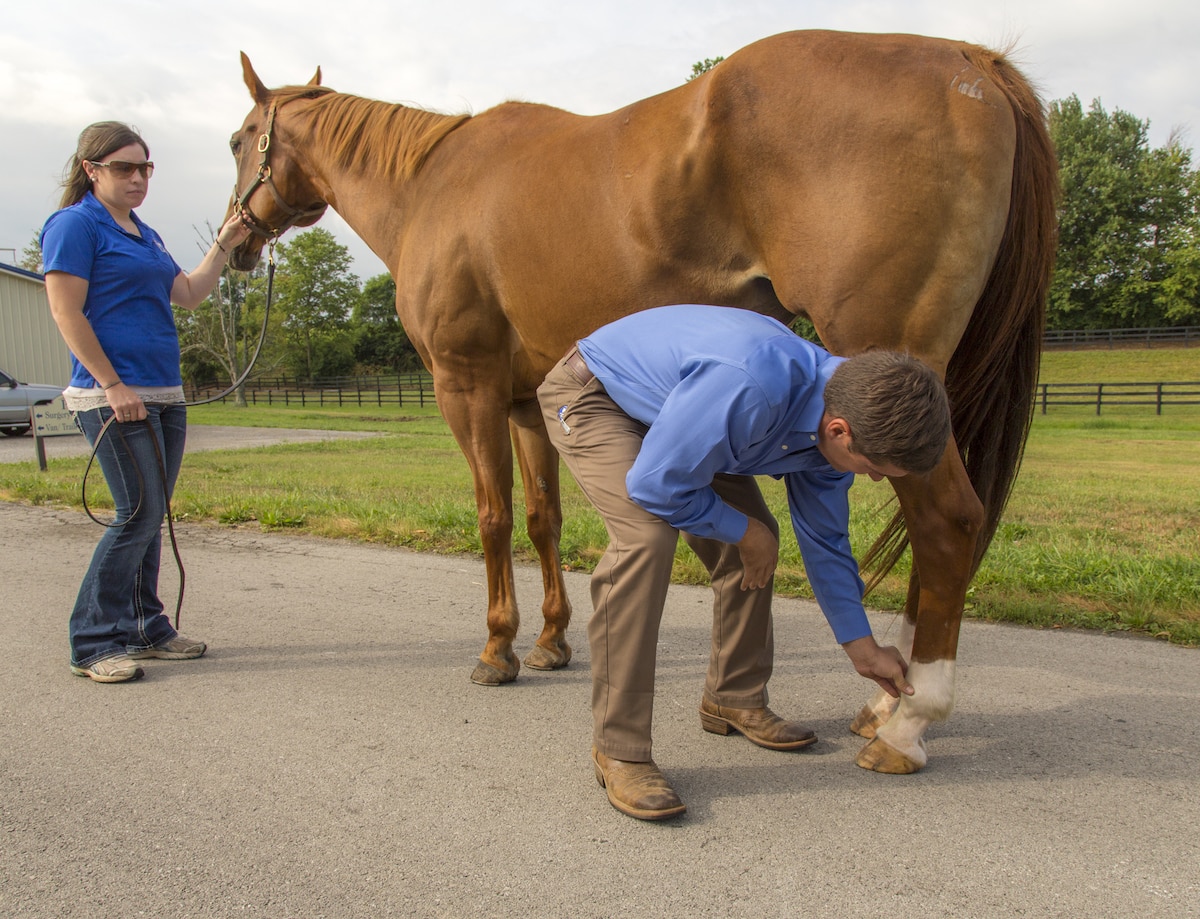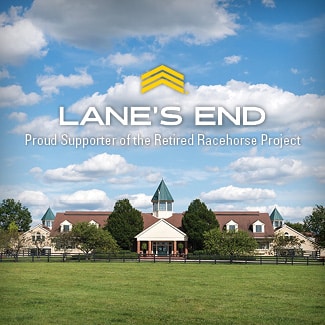Don’t overlook an OTTB with imperfect fetlocks, says a renowned equine surgeon

The horse’s ankle is a major shock absorber, stabilizer and propulsion apparatus of the distal (lower) limb. Courtesy The Horse staff
Fetlock injuries are common causes of retirement in Thoroughbred racehorses and equally common causes for concern among prospective buyers and adopters. Thankfully, with proper rehabilitation and management, many of these off-track athletes can become successful pleasure or sport horses. Over the years, Janik Gasiorowski, VMD, Dipl. ACVS, associate veterinarian and equine surgeon at the Mid-Atlantic Equine Medical Center, in Ringoes, New Jersey, has developed a growing interest in the transitioning of Thoroughbred racehorses to second careers. Here he shares his expertise on ankle injuries.
Fetlock Anatomy
Fetlocks, with their unique potential for injury, deserve our close attention. The horse’s ankle is a major shock absorber, stabilizer and propulsion apparatus of the distal (lower) limb. Racing puts unparalleled strain on this delicate structure, with all 1,200-plus pounds of the horse’s weight bearing down onto a single leg at speeds nearing 40 mph.
“A high-motion joint, the fetlock is extremely heavily and rapidly loaded in the galloping racehorse,” Gasiorowski explains.
From a biomechanical standpoint, some experts are baffled that fetlock injuries are not the source of more racehorses’ plight. This crucial structure is a complex, delicate assembly of hard and soft tissues. It encompasses the bottom of the cannon bone, the long pastern bone (P1) and two sesamoid bones attached to the cannon bone by a number of small, tough ligaments. Joints containing cartilage and capsules filled with synovial (lubricating) fluid unify all these bones. Both the superficial and deep digital flexor tendons run along the back of the fetlock, and the suspensory ligament splits into medial and lateral branches that attach to the tops of the sesamoid bones. With so many important structures packed together tightly in a high-motion joint bearing lots of strain and concussion, it’s easy to imagine something could go wrong.
How Injuries Happen
Let’s look at the impact of the above-mentioned intense weight load on a racing Thoroughbred’s fetlocks.
“The body adapts to this extreme loading by increasing the density of the condyles (protrusions at the bottom of the cannon bone) and the sesamoid bones,” Gasiorowski says. “This densification does make the bones stronger, but there’s a catch — it also causes them to lose some of the flexibility that is critical to the way they deal with strain.”
And here’s why bone flexibility matters: “If the bone can bend — at a microscopic level — it can diffuse some of the forces moving through it,” he says. “If it cannot bend, however, and force is placed on it, it will crack. These cracks start microscopically but accumulate and progress if the bone does not get time to heal them appropriately.”
This can result in a number of fracture types. “Not only that, but without a healthy bone layer to support it, the smooth, glassy, frictionless cartilage so critical to joint function is eroded away,” Gasiorowski adds. “In some ways, this (cartilage damage) is the worst of all for the OTTB because it can be difficult to recognize and, once initiated, this insidious degradation process known as arthritis can continue to advance long after the horse leaves the track.”
Types of Fetlock Injuries
It’s important to know what’s going on beneath the skin, because the structures involved influence prognosis. “As far as a joint is concerned, limitations all boil down to one thing: arthritis,” Gasiorowski says. “A mistaken belief held by many in the OTTB community is that a horse’s limitations are linked to the severity of his original injury. Instead, we need to attribute a horse’s potential limitations to the current state of arthritis.
“There is a tendency to think of the bones of a horse that was retired for injury as being fragile, permanently damaged and weak,” he continues. “In reality these bones are no weaker or more likely to fracture than those of any other horse.”
Here’s why: “Bone is one of the body’s few tissues that’s truly able to regenerate itself. Healed bone is just as strong as it was before the injury. Cartilage is not. Articular cartilage gone is articular cartilage lost forever and is the single factor (as far as a joint is concerned) that will determine the horse’s future athletic potential.”
What does this mean in terms of future soundness? “A horse with three screws in a previously fractured cannon bone can jump 1.50 meters with no more risk of injury than any other jumper, yet the same horse with the same screws but with arthritis is unlikely to make it past novice in eventing,” or lower-level dressage, Gasiorowski explains.
Different types of injuries affect prognosis and likelihood of arthritis developing, so let’s look at the most common:
Chip fractures “At best, these stay in place and just cause mild irritation,” Gasiorowski says. “Some horses will have old, rounded chips that are held securely in place by scar tissue and can be left alone without affecting the joint. At worst, however, they can come loose, get ground up in the joint and destroy the articular cartilage. Ideally, chip fractures would be removed.”
Condylar and P1 fractures “In some cases OTTBs with simple forms of these fractures make the best second career horses as far as joints are concerned; it just depends on how much cartilage damage is present,” he says, citing his own experience. “If there was significant cartilage damage at the time of fracture repair, you will start to see evidence of it developing a few months later. If the horse is five to six months out of surgery and doing well with no radiographic signs of arthritis, chances are he will continue to do well.”
Sesamoid fractures “These can be tricky,” Gasiorowski admits. “There are so many possible fracture configurations. Some OTTBs do very well with no surgery at all, while others require surgical repair or removal of the fragment. Most involve some degree of injury to the suspensory branch and/or distal sesamoidean ligaments and necessitate longer periods of rest (six to nine months) because of it.”
Rehabbing Fetlock Injuries
You’ve brought your OTTB home, armed with patience and eagerness to give him a winning start to his second-career life. If he’s experienced an ankle injury, a long recovery period might await your newly formed partnership. It can entail:
Active rest and rehabilitation “Make a specific plan with your veterinarian,” Gasiorowski says. “In general, active rest is best for most injuries. Start with small paddock turnout.” When the time comes to begin under-saddle rehab, he recommends starting with simple walking and ramping up the workload slowly. “It takes bone roughly four months to repair microdamage accumulated during fast work in training and racing,” he says. With your OTTB’s racetrack days now behind him, slow and steady wins this kind of race.
Workload “Decreasing workload (frequency, intensity or both) is the main path to career longevity for your OTTB,” says Gasiorowski. “Many joints will require no additional care; the decreased workload (from racing to another career) is enough to keep the joint healthy.”
Joint therapy Horses with mild-to-moderate arthritis can sometimes benefit from intra-articular treatments and regenerative therapies. Gasiorowski lists the most commonly used:
■ Hyaluronic acid (HA), a critical lubricating and nourishing component of joint fluid.
■ Polysulfated glycosaminoglycan (Adequan), which has been shown to have chondroprotective effects (protecting the cells that make up cartilage). It will not, however, heal preexisting cartilage damage.
■ Platelet rich plasma (PRP), which is a concentration of growth factors harvested from your horse’s own blood and aimed at promoting healing.
■ Interleukin-1 receptor antagonist protein (IRAP), an anti-inflammatory molecule, also harvested from the horse’s own blood, that blocks certain degradation pathways involved in arthritis without blocking the healing pathways.
■ Stem cells harvested from bone marrow, which veterinarians can purify and expand in culture, then inject into damaged joints to modulate inflammation and repair damaged tissues.
■ Corticosteroids, which are potent anti-inflammatory drugs that often get a bad name, because combining their use with continued heavy athletic work can lead to injury or promote arthritis development. Used in a conscientious fashion, however, their powerful anti-inflammatory effects can help horses for years to come, says Gasiorowski.
Orthopedic surgery “Thankfully not always warranted, surgery can be the saving grace of certain Thoroughbreds looking at second careers,” Gasiorowski says. “But keep in mind that while surgical intervention can limit further damage to the tissues, it will not reverse arthritic changes already present. Have a discussion with a surgeon familiar with racehorses, so together you can make the choices best for you and your horse.”
Take-Home Message
“Thoroughbreds have heart — lots of it!” Gasiorowski says. “So they may tell you they are ready to roll from Day 1, but take your time, and know that early phases of retraining are excellent physical conditioning for your horse’s ankles.”
Combine progressive rehabilitation with strategic management and veterinary care, and many OTTBs with less-than-perfect fetlocks can have productive lives long after their racing days are over.

